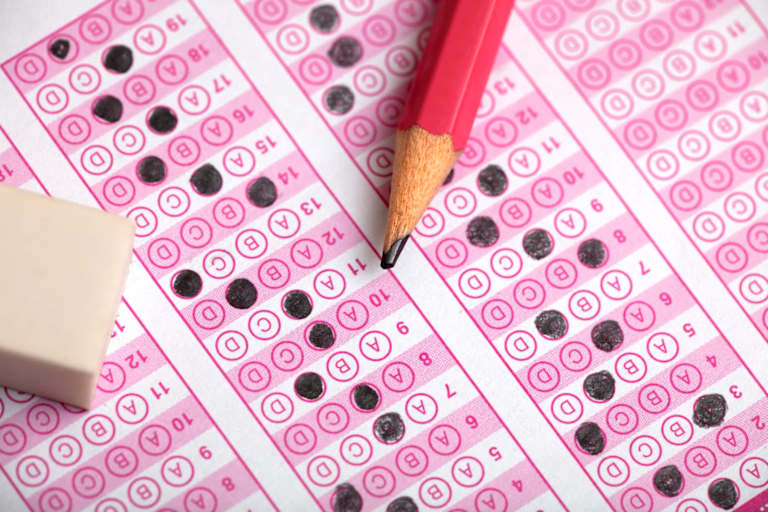A Brief History of the SAT, America’s Most Popular College Entrance Exam
- The SAT dates back to 1926 and evolved from an Army IQ test.
- The college admissions exam originally claimed to test innate intelligence.
- The test was created to promote meritocracy, but it has benefited white, privileged students.
- With many colleges going test-optional, the future of the SAT remains unclear.
During World War I, the U.S. Army needed a way to sort their new recruits and decide who would become officers, so they turned to Robert Yerkes, a psychologist who favored the brand-new IQ test, for a solution. The IQ screener Yerkes developed to test Army recruits eventually turned into the SAT.
How did the most popular college admissions exam evolve from an Army test? What does the SAT measure? And with multiple colleges dropping the SAT requirement, what does the future hold for the exam?
What Is the SAT?
The SAT is a standardized test that assesses test-takers’ readiness for college — or at least that’s what the exam’s creator and early proponents claimed.
First offered in 1926 by the College Board, the SAT has faced controversy throughout nearly a century of testing.
Carl Brigham created the SAT after working with Yerkes on the Army IQ screener, known as the Army Alpha test. Brigham brought a clear bias to intelligence testing: He believed people of color were innately less intelligent than white people.
In his book “A Study of American Intelligence,” Brigham “warned” that the decline of education would “proceed with an accelerating rate as the racial mixture becomes more and more extensive.”
At the same time, America’s elite colleges wanted a new way to identify “worthy” students who didn’t attend the preparatory schools that traditionally fed into the Ivy League.
Brigham decided to use the Army test to create a college admissions test. After the first SAT in 1926, the exam quickly grew in popularity. By 1935, Harvard University required all applicants to submit SAT scores. Multiple Ivy League schools used the exam to award scholarships.
Outside the Ivies, many colleges were slower to adopt the SAT. The University of California system, for example, didn’t require SAT scores until 1960. (As of 2021, the UC system no longer considers SAT or ACT scores when making admission decisions.)
Why Was the SAT Created?
In 1926, the first SAT tested 8,000 students on arithmetic, logic, reading, and definitions.
Early proponents of the SAT argued that the admissions exam made higher education more meritocratic. Admissions officers at elite institutions like Harvard believed the test would identify talented applicants at less academically strong high schools and accelerate their journeys into higher education.
“When these tests were originally developed, people really believed that if they did the job right they would be able to measure this sort of underlying, biological potential,” Christopher Jencks, a social policy professor at Harvard, explained in a 1999 PBS “Frontline” interview. “And they often called it aptitude, sometimes they called it genes, sometimes intelligence.”
For many at the time, the SAT was a way to “prove” the intellectual superiority of white, wealthy students, reinforce preexisting discriminatory ideas, and justify institutional racism and classism. “Underlying, biological potential” was simply a coded way of saying “white and rich.”
Critics insisted the SAT did not measure innate intelligence. Even Brigham, the creator of the SAT, later came to regret the lofty claims he’d made for the exam. In 1930, Brigham declared the SAT tested “a composite including schooling, family background, familiarity with English and everything else, relevant and irrelevant.”
Similarly, Henry Chauncey, another early proponent of the SAT at Harvard, admitted in a 1999 “Frontline” interview, “My attitude was always that the tests were very helpful, but they weren’t everything. You had to take into account whatever other records you had in making any decisions. So I’m a bit unhappy with the uses to which some colleges, or some institutions, use this.”
The SAT never tested innate intelligence. By studying, students could raise their scores. And as the SAT grew in popularity, elite students enrolled in prep courses to raise their scores, further widening the gap between already privileged students and everyone else.
The SAT, Race, and Testing Bias
From the beginning, the SAT claimed to be a meritocratic assessment. And from the beginning, students of color, low-income students, immigrants, and other historically excluded groups scored lower on the exam.
Men like Brigham concluded from the test scores that Black and Latino/a students were innately less intelligent. But the SAT was designed and modified so that white students scored higher.
For example, for years the SAT included an analogy question that asked test-takers to identify “oarsman: regatta” as the correct answer to “runner: marathon.” White students answered correctly at a higher rate than students of color — not because of innate knowledge, but because they were more likely to know the word “regatta.”
In 1998, the SAT tested two questions and found that Black students answered one correctly at a higher percentage than other groups, whereas white students disproportionately answered the other question correctly. The SAT later discarded the question on which Black test-takers outscored white test-takers — but kept the question on which white students scored higher.
“We still think there’s something wrong with the kids rather than recognizing there’s something wrong with the tests,” historian Ibram X. Kendi explained to the National Education Association in 2021. “Standardized tests have become the most effective racist weapon ever devised to objectively degrade Black and brown minds and legally exclude their bodies from prestigious schools.”
While the SAT has long claimed to be a neutral, meritocratic assessment, it carries a legacy of bias. Moreover, wealthy students can afford to boost their scores with expensive test prep.
As Nicholas Lemann, author of “The Big Test: The Secret History of American Meritocracy,” pointed out to “Frontline” in 1999, “People will start madly manipulating the system to their favor and to the favor of their children. And the people who have more money and more power and more sophistication will be able to manipulate it more successfully.”
To address inequities among test-takers, the College Board tried to implement an adversity index in 2019. This score — a single number between 1 and 100 — was intended to shed light on a student’s socioeconomic environment and would appear alongside their test scores.
Sharp criticism around the index’s oversimplification, however, led the College Board to quickly abandon the adversity score.
The Future of the SAT
Throughout its history, the SAT has modified its format and questions with the goal of removing bias. But increasingly, colleges no longer believe the SAT should play a major role in admissions.
In 2021, the University of California system ended its 60-year use of the SAT. Many institutions have joined the UC schools in going test-optional. Nearly 80% of four-year institutions do not currently require the SAT or ACT, mainly as a result of the COVID-19 pandemic.
As colleges signal a move away from the SAT, students increasingly choose not to submit their test scores. In 2021, just 51% of applicants who used the Common App submitted test scores, a significant drop from 78% in 2019.
And the groups harmed by testing bias were even less likely to submit scores: Just 40% of students of color and 37% of first-generation college students included test scores with their applications.
In response to these trends, the College Board has announced changes to the SAT. By 2024, students will no longer take the exam on paper — instead, the SAT will move to a digital format. Students can use their own device, a school-issued device, or one provided by the College Board to take the exam. The test will also cut its time limit from three hours to two, allow calculators for the entire Math section, and reduce the length of its reading passages.
The SAT emerged in an era of burgeoning college admissions when the prep school-to-Ivy League pipeline began to break down. But the SAT’s decline in today’s era reveals the limits of standardized testing.
Frequently Asked Questions About the History of the SAT
From 1926-1993, SAT stood for Scholastic Aptitude Test. However, the College Board changed the name in the 1990s because “aptitude” implied that the SAT measured innate intelligence. For a brief time, the test was known as the Scholastic Assessment Test. In 1997, the College Board finally decided to call it simply by its abbreviation: the SAT.
Explore More College Resources

What Is a Bad SAT Score — And Should I Worry About Mine?
What is a low SAT score? Find the bottom SAT scores for popular and competitive colleges. Plus, get expert tips to improve your score.

by Jane Nam
Updated March 20, 2024

All About SAT Scores: National Average and Full Statistics
Read about average SAT scores broken down by school, state, race/ethnicity, and gender.

by Jane Nam
Updated May 9, 2025

